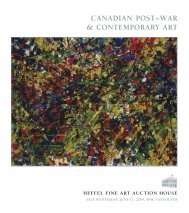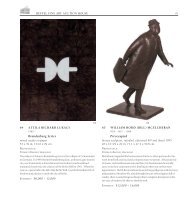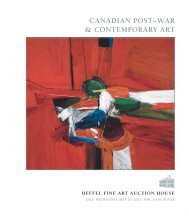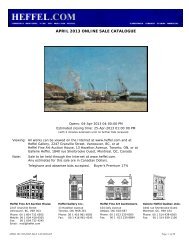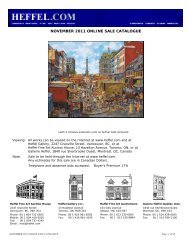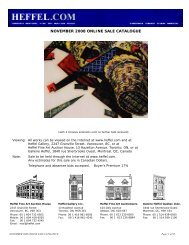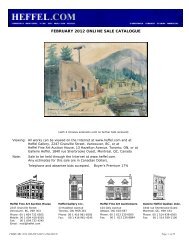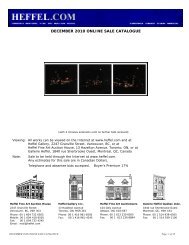Download Auction Catalogue in PDF Format - Heffel
Download Auction Catalogue in PDF Format - Heffel
Download Auction Catalogue in PDF Format - Heffel
Create successful ePaper yourself
Turn your PDF publications into a flip-book with our unique Google optimized e-Paper software.
HEFFEL FINE ART AUCTION HOUSE 15<br />
106 JAMES EDWARD HERVEY (J.E.H.)<br />
MACDONALD<br />
ALC CGP G7 OSA RCA 1873 ~ 1932<br />
Early Autumn, Montreal River, Algoma<br />
oil on board, signed and dated 1919<br />
and on verso signed, titled and <strong>in</strong>scribed 28992<br />
8 1/2 x 10 3/8 <strong>in</strong>, 21.6 x 26.3 cm<br />
PROVENANCE:<br />
Acquired directly from the Artist by<br />
Percy and Gertrude Wells Hilborn, Ontario<br />
By descent to the present Private Collection, Ontario<br />
LITERATURE:<br />
Charles C. Hill, The Group of Seven: Art For A Nation,<br />
National Gallery of Canada, 1995, pages 79 and 80<br />
Early Autumn, Montreal River, Algoma is a delightful and joyous bouquet of<br />
colour. Related closely to several of J.E.H. MacDonald’s masterworks such<br />
as October Shower Gleam and The Solemn Land, this work comes from the<br />
second boxcar trip arranged by Lawren Harris <strong>in</strong>to Algoma country.<br />
Harris, after his discharge from the army <strong>in</strong> 1918, had traveled to<br />
Manitoul<strong>in</strong> Island with James MacCallum on a respite to aid <strong>in</strong> his<br />
recovery. Not f<strong>in</strong>d<strong>in</strong>g the scenery to his lik<strong>in</strong>g, Harris suggested a side trip<br />
on the Algoma Central Railway to f<strong>in</strong>d more appeal<strong>in</strong>g views. It was on<br />
this side trip that he first encountered Algoma and the <strong>in</strong>spiration for the<br />
boxcar trips came. Harris organized the first boxcar excursion <strong>in</strong> the fall of<br />
that year and <strong>in</strong>cluded Frank Johnston and MacDonald ~ whom he had to<br />
urge, as MacDonald was also recover<strong>in</strong>g from recent illnesses. A third trip,<br />
the second of the boxcar expeditions, saw the <strong>in</strong>clusion of A.Y. Jackson,<br />
who had just returned from France, and took place <strong>in</strong> September of 1919.<br />
Jackson describes the scenery as vivid with chang<strong>in</strong>g hues: “The colour is<br />
disappear<strong>in</strong>g very fast. The reds were gorgeous when we first came, but<br />
now it is all orange and yellow.” This strik<strong>in</strong>g work comes from that trip,<br />
and if we can take Jackson’s writ<strong>in</strong>g literally, it comes from early <strong>in</strong> the<br />
trip, as the reds are <strong>in</strong>deed gorgeous.<br />
At this time, MacDonald’s pa<strong>in</strong>t<strong>in</strong>g was heavily <strong>in</strong>fluenced by his work <strong>in</strong><br />
design. There is a clear l<strong>in</strong>k between this rhythmic pa<strong>in</strong>t<strong>in</strong>g and the<br />
artistry of his beautiful bookplates and lyrical poster designs, but<br />
Algoma’s ruggedness would add an edge to MacDonald’s work that had<br />
not been there before; where<strong>in</strong> gentility is replaced by wildness, soft l<strong>in</strong>es<br />
replaced by bold ones and low~keyed colour heightened by the vivid fall<br />
hues he saw at Algoma. He described the land as be<strong>in</strong>g “after Dante’s<br />
heart. The canyon is like a w<strong>in</strong>d<strong>in</strong>g way to the lower regions and last<br />
night, when the tra<strong>in</strong> went through just after dark, with the fireman<br />
stok<strong>in</strong>g up, the light of the fire sh<strong>in</strong><strong>in</strong>g on the smoke clouds, it was easy<br />
to imag<strong>in</strong>e his Satanic majesty tak<strong>in</strong>g a drive through his doma<strong>in</strong>…The<br />
great perpendicular rocks seemed to overhang as though they might fall<br />
any m<strong>in</strong>ute and the dark Agawa mov<strong>in</strong>g quietly through it all had an<br />
uncanny snak<strong>in</strong>ess. On a f<strong>in</strong>e day, such as this, the canyon seemed to lead<br />
upwards and has all the attributes of an imag<strong>in</strong>ed Paradise, except<strong>in</strong>g,<br />
perhaps, anyth<strong>in</strong>g <strong>in</strong> the way of meadows. There are beautiful waterfalls<br />
on all sides, and the f<strong>in</strong>est trees ~ spruce, elm, and p<strong>in</strong>e.”<br />
Early Autumn, Montreal River, Algoma literally dances with colour, pattern<br />
and movement. The repeat<strong>in</strong>g chevrons of brushwork <strong>in</strong> the foreground<br />
forest are echoed and balanced by the vibrant blues <strong>in</strong> the sky, and the<br />
deep <strong>in</strong>digo of the river, almost dead centre <strong>in</strong> the work, is especially rich.<br />
MacDonald was a master of colour, often not<strong>in</strong>g <strong>in</strong> the marg<strong>in</strong>s of his<br />
notebooks which pigments were essential for the region he was<br />
sketch<strong>in</strong>g. His ability to observe and to translate the essential character<br />
of the landscape <strong>in</strong>to his sketches was foundational <strong>in</strong> his art, and proved<br />
<strong>in</strong>valuable to his career. As MacDonald <strong>in</strong>creased <strong>in</strong> stature as an<br />
educator, he devoted more and more of his time to teach<strong>in</strong>g and had less<br />
time to sketch <strong>in</strong> the field. He would rely on his ple<strong>in</strong> air sketches for<br />
<strong>in</strong>spiration when he had time to work <strong>in</strong> his studio. Gems such as this<br />
evocative pa<strong>in</strong>t<strong>in</strong>g were essential to him as they had the power to<br />
transport him back to the hills above the Montreal River, to take him back<br />
<strong>in</strong>to the wilderness that laid the foundations for his early masterworks.<br />
This sketch comes to auction at <strong>Heffel</strong> through the family of Percy and<br />
Gertrude Wells Hilborn and their daughter Esther, and by association<br />
with their friends Sam and Kitty Williams. The Williamses had a cottage<br />
on Georgian Bay, and were neighbours of one of Jackson’s cous<strong>in</strong>s who<br />
also had a cottage there. The Williamses frequently enterta<strong>in</strong>ed the<br />
Hilborns and members of the Group at their cottage and supported them<br />
by purchas<strong>in</strong>g their work, especially that of Jackson. The Hilborns<br />
donated Jackson’s masterwork canvas First Snow, Algoma to the<br />
McMichael Canadian Art Collection <strong>in</strong> 1969 and Esther subsequently<br />
made important gifts to the McMichael Canadian Art Collection, the<br />
National Gallery of Canada and the Kitchener~Waterloo Art Gallery.<br />
ESTIMATE: $80,000 ~ 100,000



